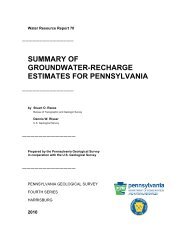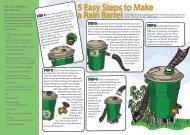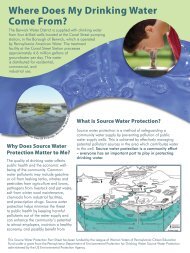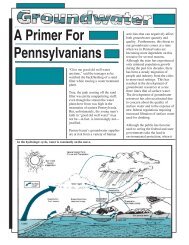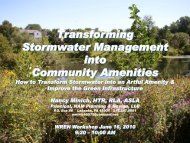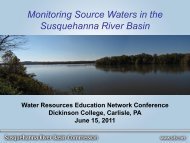NITROGEN POLLUTION: - Hubbard Brook Research Foundation
NITROGEN POLLUTION: - Hubbard Brook Research Foundation
NITROGEN POLLUTION: - Hubbard Brook Research Foundation
Create successful ePaper yourself
Turn your PDF publications into a flip-book with our unique Google optimized e-Paper software.
Additional reactive nitrogen created through human activities becomes a pollution<br />
problem when the supply of reactive nitrogen from all sources entering a watershed<br />
exceeds the basic needs of the plants, microbes and animals in that watershed, or when<br />
nitrogen emitted to the air cannot be assimilated without adverse effects on air quality.<br />
The Cascade of Nitrogen Pollution<br />
Air quality impacts:<br />
~ Elevated ground-level ozone<br />
~ Increased particles in the air<br />
~ Reduced visibility<br />
~ Increased acid rain and nitrogen deposition<br />
Forest impacts:<br />
~ Increased acidity of forest soils<br />
~ Nitrogen saturation of forest ecosystems<br />
~ Ozone damage to forests<br />
Water quality impacts:<br />
~ Elevated acidification of lakes and streams<br />
~ Groundwater contamination<br />
~ Over-enrichment of coastal ecosystems<br />
Other impacts:<br />
~ Increased production of greenhouse gases contributing to global climate change<br />
~ Adverse human health effects from particulate matter and ground-level ozone<br />
What are the sources of reactive nitrogen in the<br />
Northeast<br />
The largest sources of reactive nitrogen in Northeast watersheds are<br />
nitrogen in food, nitrogen deposition and nitrogen fertilizer.<br />
To determine the sources<br />
of reactive nitrogen that<br />
cause nitrogen pollution we<br />
analyzed eight large watersheds<br />
in the Northeast (see<br />
Figure 2b). The results show<br />
that food (most of which is<br />
imported from outside the<br />
region) accounts for the<br />
largest amount of reactive<br />
nitrogen in the region (38-75<br />
percent). Airborne emissions<br />
of nitrogen oxides (NO x<br />
) and<br />
ammonia (NH 3<br />
), and the<br />
subsequent deposition 2 of<br />
nitrate (NO 3<br />
) and ammonium<br />
(NH 4<br />
), contribute 11-36<br />
percent. Nitrogen fertilizer<br />
2<br />
Deposition is the transfer of<br />
nitrogen from the air to the<br />
Earth’s surface through rain,<br />
snow, clouds, fog, gases, or<br />
particles.<br />
PAGE 6<br />
o<br />
o<br />
N Inputs to Watersheds<br />
(kg N/ha-yr)<br />
80<br />
60<br />
40<br />
20<br />
0<br />
Casco Bay, ME<br />
Northeast<br />
Great Bay, NH<br />
Merrimack Bay, MA<br />
Massachusetts Bay, MA<br />
Buzzards Bay, MA<br />
Narragansett Bay, RI<br />
N in food<br />
Atmospheric N deposition<br />
Fertilizer N<br />
N in feed<br />
N fixation<br />
Long Island Sound, CT<br />
Raritan Bay, NY<br />
Chesapeake Bay, MD<br />
FIGURE 4:<br />
Total reactive<br />
nitrogen inputs<br />
to several large<br />
watersheds in<br />
the Northeast<br />
and mid-Atlantic.<br />
mid-Atlantic<br />
Pamlico Sound, NC<br />
Note: nitrogen inputs are calculated for the watershed draining each estuary.<br />
k



